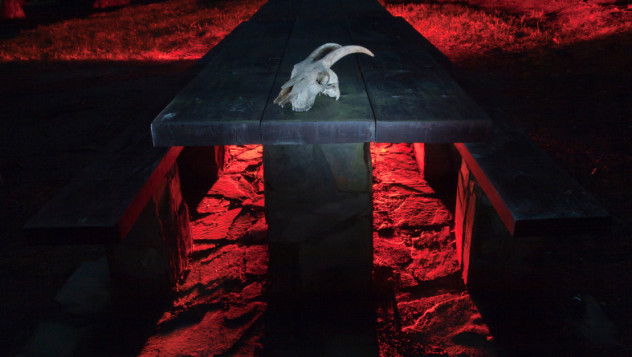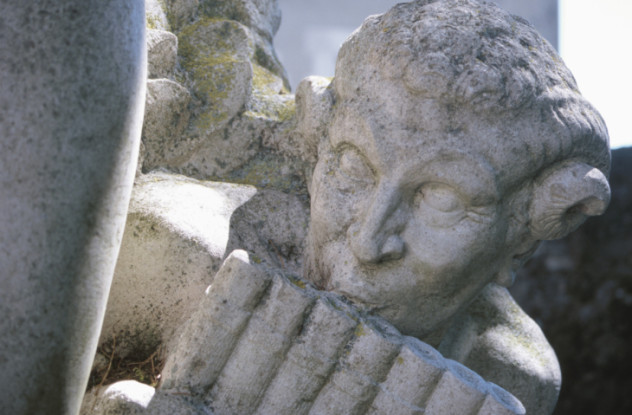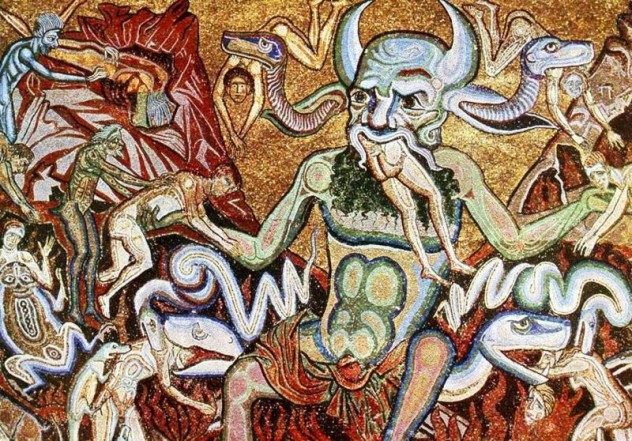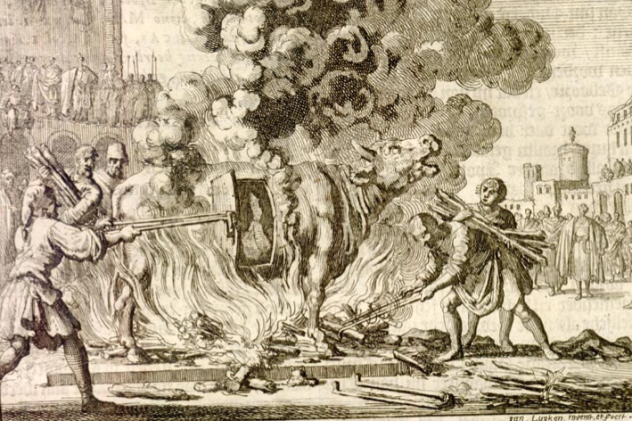SEE ALSO: 10 Unsolved Mysteries About Satan
10 The Church Of Satan Doesn’t Worship Satan
Popular images of the Church of Satan frequently depict ethically questionable people who perform dark rites, sacrifice animals, drink the blood of small children, or something else to that effect. According to the Church of Satan itself, though, worshiping Satan isn’t what they’re about at all. Their mission statement stresses that they don’t believe in a literal Satan. Instead, Satan is used as a metaphor to represent their belief in the power of fantasy, which they say they share with many other religions. Satanists use Satan as an opposition to the fiction and the fantasy of the presence of an otherworldly, divine figure—like Christ. Rather than worshiping someone they consider just another fictional character, Satanists do the opposite by putting their faith in the worldly and tangible. The use of Satan is simply a symbol for their devotion to earthly things and their belief that they should revere other people at the same level usually reserved for the deities of other religions. The church goes on to say on its website that these are complicated concepts, and some people don’t understand. “Satanism is not intended for dummies. Satanism demands study—not worship. The capacity to think is expected of Satanists.”
9 The Number Of The Beast Isn’t 666
Frequently featured in heavy metal posters and bad tattoos, the number 666 has long been identified as the number of the beast. It’s cited from the Book of Revelation, in which John associates the number with the Antichrist, but the details of the story aren’t entirely clear. Archaeologists have stacks and stacks of nearly indecipherable manuscripts from historic dump sites in Egypt that date to the third or fourth century. Researchers have been able to translate more of the writing by utilizing recent improvements in photographic imaging techniques. On one piece of parchment, the number assigned to the proverbial beast is 616—not 666. According to Oxford’s Centre for the Study of Ancient Documents, deciphering the number of the beast all comes down to numerology. In the time this parchment was made, writing could be a dangerous act, especially for those who expressed their opposition to the controlling power by drawing comparisons to the Devil. For this reason, numerology was used to give people the option to assign numbers and leave out names. In order to decode the numbers, we need to know a little about both the writing system and how people thought. The number of the beast is derived from the name of the person who, at the time, was thought to be the earthly incarnation of the Devil, Nero. The number itself depends entirely on the translation of the name. When the name is translated from its Greek form—Nero Kesar— to its vowelless Hebrew form—NRWN QSR—the numerical value is 666. One theory states that the earlier text has a Latin base. This makes the numerical value 616 when translated back into Hebrew again.
8 Lucifer Isn’t Another Name For Satan
Anyone who’s been to Sunday School knows the story: Satan was originally an angel named Lucifer who turned on God and was cast down from Heaven. The thing is, that story is nowhere in the Bible. The one time Lucifer is mentioned is from a relatively new translation, and it’s also a misinterpretation. The only occurrence of the name Lucifer in the Bible is in Isaiah 14:12, in this verse: “How art thou fallen from heaven, O Lucifer, son of the morning! How are thou cut down to the ground, which didst weaken the nations!” Seems pretty straightforward, but it turns out that it’s another case of misinterpretation and mistranslation. If you go back to the original Hebrew text, you find a story not about a fallen angel, but about a Babylonian king who figuratively fell from his throne when he began persecuting the Israelites. By the time the book was translated by Christian writers, the king became an angel. The name Lucifer comes in when the king’s name, Helal, gets translated. Helal means “day star” or “son of the dawn.” The Romans found a word close in meaning. Lucifer is the Roman name for the planet we call Venus, which is often the first visible celestial body to appear near dawn. The name didn’t have anything to do with the appearance of a Satan-like figure until much later, when its imagery was cemented with a fourth-century translation of the text by Jerome.
7 The Satanic Pentagram Is Pretty New
Similarly to the perversion of the swastika’s symbolism from good fortune to the Third Reich, the pentagram has undergone a surprisingly recent transformation. Today, the upside-down pentagram is often decorated with the goat’s head of the Devil, but its original meaning and connotations were polar opposites of Satanism. Early references to the design attribute the five points of the star to the five wounds Christ suffered as he was crucified. It’s often still used in this way in Mormon art and architecture. It was only with the founding of the Church of Satan that the pentagram was used to represent a goat’s horns, ears, and beard. Church historians have traced the goat’s head pentagram back to an image in an 1897 book called La Clef de la Magia Noire written by Stanislas de Guaita, a French occultist and proponent of the distinction between occultism and Devil worship. Not long before that, another French occultist named Eliphas Levi wrote about the evil connotations between the pentagram and a goat-headed figure. By 1924, the goat’s head had crept into the pentagram and the image was labeled “the pentagram expressive of subversion” in a text called Science Occulte et Magie Pratique. The Church of Satan’s adoption of the image further tied its meaning to the Devil.
6 The Goat-Headed Satan Is Also Pretty New
If one were to search the Bible for descriptions of Satan with a goat’s head, one might turn up a few mentions of the forbidden worship of goat idols and demons in Leviticus 17:7 and maybe some calf idols in Exodus. So, where does the goat-headed man come from? The symbol of Satan as a half-goat creature is known as Baphomet, and the link between the goat-headed demon and Satan only happened when people started throwing stones at the Freemasons. The story says that when the Pope turned his attention to the Knights Templar and issued arrest warrants for those he knew to be members of the organization, he cited the worship of a demon called Baphomet as one of the foremost pieces of evidence against them. The name hadn’t been assigned to the image yet, though, and trial records show that of the 231 knights who were interrogated by the pope’s agents, only 12 admitted (under torture) that they had a passing familiarity with the image of the unnamed, demonic goat. But as for the depiction of the goat, that’s been traced back to the writings of Eliphas Levi, about 600 years after the Templars had their run-in with the Pope. Levi gave the goat-headed creature the name Baphomet, harkening back to a ram-headed Egyptian god named Banedbjedet. The image of the goat within the pentagram then came from the adoption of the image of the Goat of Mendes, which was associated with another ram-headed Egyptian god, Amon. Today, the link between the Satanic goat and the Devil is complete with the trademark of the image by the Church of Satan.
5 Christians Didn’t Get Satan From Pan
There seems to be an obvious connection to be drawn between Pan, the goat-legged satyr, and the habit early Christians had of adopting others’ deities and then assigning them less-than-favorable roles. This leads us to another misconceptions about Satan: The Devil was not originally associated with Pan, but Christ was. Pan, the son of the god Hermes, was one of a handful of figures in the pastoral pantheon in Greece. They were worshiped by farmers and shepherds, many of whom would pray to Pan to watch over their flocks, and he was often called on protect sheep from vicious wolf attacks. Sounding familiar? Christianity’s patron saint of shepherds, Saint Bartholomy, even shares an island shrine with him. According to one rarely repeated part of the story about the birth of Christ, when the Christians’ Good Shepherd was born, a voice was heard by a shipmaster named Thamus, instructing him to recite, “Magnus Pan mortuus est,” (“The great Pan is dead!”) when spreading the word of the birth of Jesus Christ. Why did the image of Pan switch sides? The church might have approved of Pan’s image as a shepherd, but they certainly didn’t approve of his other role as a fertility god. While the parallels between Pan and Christ survived as far along as Milton’s Paradise Lost, the church soon decided that the lusty satyr was more in line with the sexual morals of the Devil than of Christ.
4 The Upside-Down Cross Is A Respectful Symbol
One of the most prevailant assumptions—especially in movies like The Omen and in the death metal world—is that the upside-down cross is one of Satan’s symbols. This assumption is based in the idea that it’s a reversal of Christ’s ultimate sacrifice, but that’s only half true. The upside-down cross is traditionally viewed as not only a Christian symbol, but as one of humility. As the story goes—and it’s a story that can be traced back to some of the earliest Christian writings of men like St. Clement of Rome, St. Ignatius of Antioch, and Eusebius of Caesarea—St. Peter was crucified in Rome by the order of Emperor Nero, who was making a stand against the then-burgeoning religion of Christianity. Not wanting to dishonor the supreme sacrifice that Christ had already made, Peter requested that he be crucified upside-down. The upside-down cross then became a symbol of humility, worn by those who, in the same spirit of Peter, wish to pay respect to the sacrifice made by Christ. That’s why it’s on the back of the Pope’s chair: The man acting as Pope steps into the shoes first worn by St. Peter, and the symbol of the cross has also been passed down. It’s been suggested that the presence of the cross on the back of the Pope’s chair suggests that he’s actually in league with Satan himself, but it seems like a pretty unlikely (and rather obvious) way of showing it. For some, the upside-down cross has been moved into the territory of fashion, with jewelry-makers selling not only crosses facing in both directions, but also sideways.
3 His Demons Aren’t That Bad
… according to The Goetia: The Lesser Key of King Solomon, an anonymously written grimoire. The story says that King Solomon was once the most wise of all kings and could speak with man, beast, demon, and angel alike. Solomon’s temple was built only with the assistance of demons, particularly one named Asmodeus. While Solomon’s demons had a handful of the traditional characteristics we associate with them—tendencies to trick, lie, and manipulate—they’re not the mindless, mind-controlled troublemakers we usually think of now. They definitely weren’t little, red, fork-tailed monsters. As far back as the 16th century, writers were compiling lists of demons and how to summon and control them. Precisely when The Goetia: The Lesser Key of King Solomon was first organized is unknown, although parts of it echo through earlier works. The book is said to contain all the information you need to summon 72 demons, the same demons that Solomon used to build his temple. While we might usually think of demons being summoned into the world to quite literally unleash hell, they’re not that one-dimensional. The 10th demon, Buer, teaches his summoners the healing properties of plants and herbs, gives good familiars, and can heal “distempers.” Eligos, the 15th demon spirit, appears as a knight and can see the future and reveal secrets. Naberius can give the gift of rhetoric and restore lost position and honors. See? They’re not so bad.
2 Satan Is Not Destined To Rule In Hell
Call him the Prince of Hell or the Prince of Darkness, and the job is clear. When it comes to the place where Satan’s going to spend eternity, it’s clearly Hell . . . right? According to Paul in Hebrews 2:14, Christ will “destroy” Satan. That doesn’t mean killing him though—the word used is “katargeo,” which means defeating or putting someone away. Hell isn’t the domain of Satan. It’s his prison, where the Bible says he’ll be tortured just like all the others who have turned away from God. Revelation 20:10 also supports this interpretation. According to this verse, Satan’s destiny has already been decided, and it’s being cast into Hell’s lake of fire. This blurs into another misconception about Satan’s role in Hell; according to popular belief, it’s Satan that barters for souls and banishes them to Hell for eternal punishment. In this same part of Revelation (and in Matthew 25:46), it’s also said that because of the bestowing of free will on mankind, it’s not Satan that’s stealing souls and turning them evil; evil is a choice made by each person. It’s also said that God will punish all those who turn to evil in the same way—including Satan himself.
1 Satan Doesn’t Live In Hell . . . He Lives In Turkey
One of the most universally accepted facts about Satan—that he rules over all the demons in Hell—is also one of the most incorrect. According to the Bible, Satan doesn’t rule in Hell and doesn’t live there, either. He lives on Earth, walking among us and tempting us to commit sins and turn to his side. The Book of Revelation goes a step farther and names the ancient Turkish city of Pergamum as the “Throne of Satan.” Specifically, it’s thought that it was a literal throne, with the temple once known as the Great Altar of Zeus repurposed as the Devil’s throne. The prophet John says: “To the angel of the church in Pergamum write: I know your works, and where you dwell, where Satan’s throne is. And you hold fast to my name, and did not deny my faith even in the days in which Antipas was my faithful martyr, who was killed among you, where Satan dwells.” In the context of the time, a throne is much more than just a chair—it’s a home. John’s words to the people of Pergamum are an expression of gratitude for their faith while one of their own suffered one of the many horrible deaths inflicted upon the martyrs. Pergamum was home to the Asklepion, one of the most successful hospitals of the day, built in honor of the healing god Asklepios. Those who were ill would take a sleeping potion and spend the night surrounded by snakes said to bring them dreams from Asklepios. Once the dreams were interpreted by their doctors, they could be cured. Once Christianity came to the city, the priests that were doing the interpreting pleaded with the city officials to run the Christians out of town—they were interfering with their spirits and the presence of their gods. One of the most vocal, a man named Antipas, was instructed to forsake his Christian ways and swear allegiance to Rome. He refused and was burned alive in the brass bull on the top of the Altar of Zeus. But that’s absolutely not the end of the story. In the mid-19th century, a German engineer named Carl Humann visited the ruined city. He petitioned the respective governments to excavate the city and remove and take what artifacts he could back to Germany. The Pergamon Museum opened in 1930. Its center attraction was the reassembled Great Altar of Zeus. Several years later, Albert Speer would look to the altar for inspiration to create an eerie parallel. Adolf Hitler wanted him to design parade grounds, and Speer took the altar and recreated it on a massive scale. He replaced the bronze bull in which Antipas had been martyred with Hitler’s podium, where he would stand to announce the Nuremberg Laws. Read More: Twitter
























